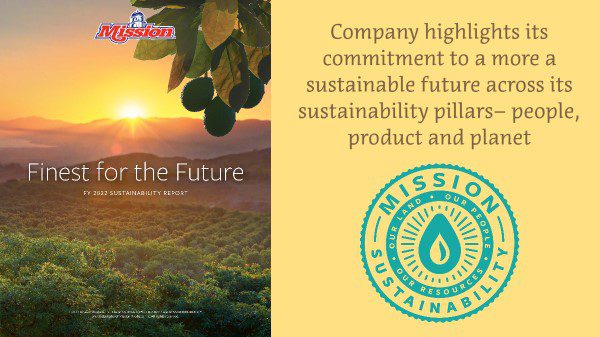OXNARD, Calif. – Mission Produce, Inc. (“Mission” or “the Company”) BB #:118126 a world leader in sourcing, producing, and distributing fresh Hass avocados with additional offerings in mangos and blueberries, today announced the release of its third annual sustainability report, “Finest for the Future,” which communicates the Company’s global sustainability story during fiscal year (FY) 2022. The report details Mission’s operating procedures, projects and achievements, as well as reports on the Company’s global use of resources.
“For 40 years, we have invested in sustainable practices to protect our land, preserve our resources and support the health and safety of our people,” said Steve Barnard, Chief Executive Officer. “We strive to create a positive impact not only for our company, but for the communities and environments in which we operate.”
Mission’s sustainability highlights for FY 2022 include:
• People: From FY 2020 to FY 2022, Mission’s global charitable giving has increased by 450%, contributing to causes supporting children, families and agriculture education. One of its largest investments in 2022 involved significant infrastructure developments in La Libertad, Peru, where Mission supported the renovations of several public buildings and the construction of a bypass for clean drinking water. These advancements aim to improve quality of life for the communities surrounding Mission’s Peruvian field and packhouse operations.
• Product: As part of the Company’s commitment to reduce the environmental impact of its products, Mission has a goal to reduce the plastic in 50% of the bags packed and shipped globally by FY 2025. In FY 2022, 46% of Mission’s bags were made with reduced plastic, and since FY 2021, the Company has saved an estimated 5.4 million grams of plastic, the equivalent of 420,000 plastic bottles.1
• Planet: In FY 2022, Mission planted nearly 200,000 new trees in harmony with the existing ecosystems of its managed farms in Peru, Guatemala and Colombia. Mission’s avocado trees provide a dual impact in combatting climate change– they convert carbon dioxide (CO2) into oxygen through photosynthesis, as well as capture and store CO2 through carbon sequestration. In FY 2022, the CO2 stored by Mission’s trees in Peru is estimated to equal at least 21% of Mission’s total reported emissions.2
“Mission’s approach to sustainability is strategically designed to focus on the areas and risks most relevant to our business,” said Delanie Beeson, Global Science and Sustainability Manager. “We seek to minimize the impact of our global footprint and consistently evaluate opportunities to implement sustainable practices throughout our operations. Each of our initiatives is developed and executed to mitigate important sustainability risks affecting our people, product and planet.”
For more information on Mission’s commitment to sustainability and to download the full FY2022 sustainability report, visit www.missionproduce.com/sustainability


About Mission Produce, Inc.:
Mission Produce is a global leader in the worldwide avocado business. Since 1983, Mission Produce has been sourcing, producing and distributing fresh Hass avocados, and as of 2021, fresh mangos, to retail, wholesale and foodservice customers in over 25 countries. The vertically integrated Company owns and operates four state-of-the-art packing facilities in key growing locations globally, including California, Mexico and Peru and has additional sourcing capabilities in Chile, Colombia, the Dominican Republic, Guatemala, Brazil, Ecuador, South Africa and more, which allow the Company to provide a year-round supply of premium fruit. Mission’s global distribution network includes 13 forward distribution centers that are strategically positioned in key markets throughout North America, China, Europe and the UK, offering value-added services such as ripening, bagging, custom packing and logistical management. For more information, please visit www.missionproduce.com.
End Notes
- Calculated using the U.S. Environmental Protection Agency’s (EPA) Greenhouse Gas Equivalencies Calculator.
- Calculated using carbon sequestration data from a study done by Instituto de Investigaciones Agropecuarieas Santiago, “Huella de carbono en productos de exportación agropecuarios de Chile.”



